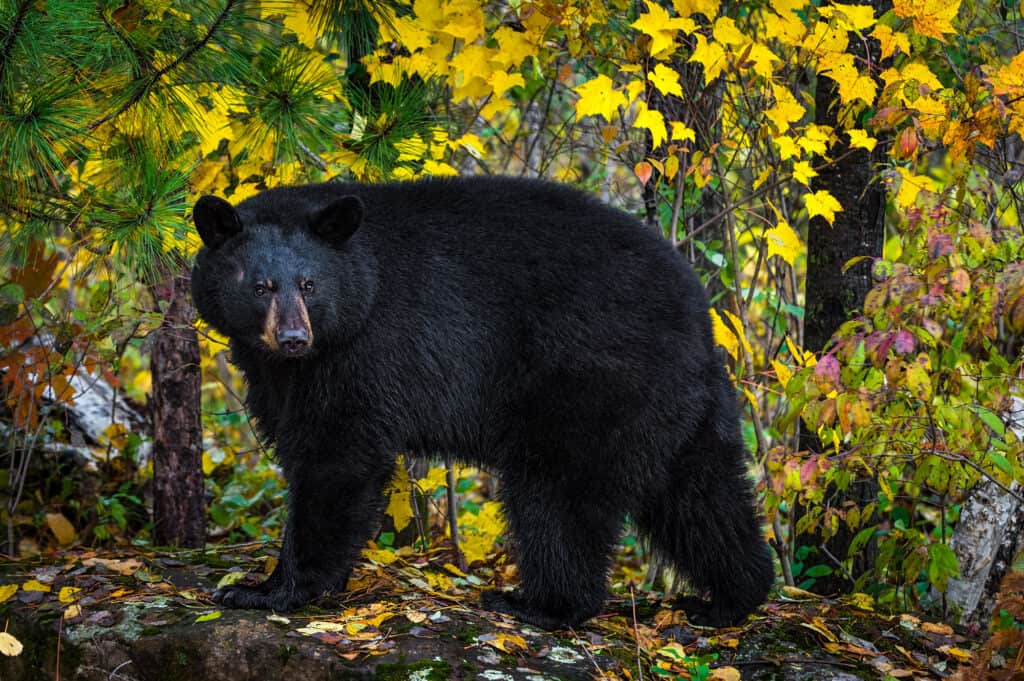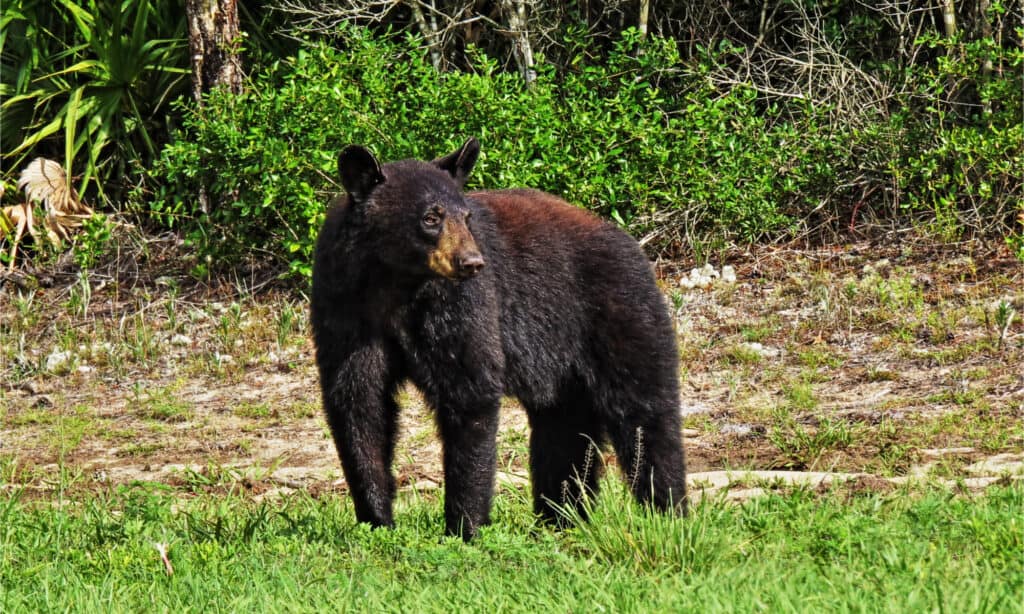Florida was once home to a flourishing population of bears that ranged throughout the state’s mainland and included coastal islands and large keys. After a period of setbacks following the arrival of settlers, bears managed to recover and once again roam the wilderness. This has occasionally led to conflict between humans and bears. Read on to discover the largest bear ever caught in Florida!
The Largest Bear Ever Caught in Florida

A black bear weighing 740 pounds is the largest bear caught in Florida.
©Holly Kuchera/Shutterstock.com
The largest bear ever caught in Florida was a black bear weighing 740 pounds. On January 18, 2015, five wildlife officials in Seminole County trapped the bear and killed it in response to a steady stream of complaints. Another bear in the same county weighed an estimated 760 pounds, just slightly heavier than the one officials killed.
Observers caught these and other bears entering backyards, climbing trees, and riffling through garbage. Due to the increasing number and size of black bears in the state, officials are advising increased caution. Human-bear encounters are likely to become more common as human populations also expand and urban sprawl intrudes into traditional wilderness areas.
Black Bear: Types and Appearance
The Florida black bear (Ursus americanus floridanus) is one of 16 subspecies of the American black bear (Ursus americanus), which is currently the only bear species in Florida. The other two North American bear species, the brown bear (Ursus arctos) and the polar bear (Ursus maritimus) live elsewhere on the continent. The black bear is smaller than both of these species. In Florida, adult males typically weigh between 250 and 450 pounds with adult females weighing between 125 and 250 pounds. Black bears in the state stand between 2.5 and 3.5 feet at the shoulder and average 4-6 feet in height.
Black bears come in various colors, including black, brown, cinnamon, bluish-grey, blond, and white. White “spirit” or “Kermode” bears (Ursus americanus kermodei) do not range outside British Columbia in Canada. In Florida, the only pelt color is black, though some individuals have white markings on their chests.
Black Bear: Habitat
Black bears enjoy habitats with dense understories like forests, scrublands, shrublands, hammocks, and forested wetlands. However, they will take advantage of any available habitat including grasslands, deserts, and swamps. In Florida, black bears currently occupy 49% of their historic range, which is up from 18% in the 1970s. The species inhabits 40 states throughout the United States, including Alaska, as well as areas in Canada and Mexico.
In Florida, adult male bears have a range of up to 60 square miles while females usually remain within a 15-square-mile area. Male ranges typically overlap with those of a number of females for breeding purposes.
How Many Black Bears Are There in Florida?

There are more than 4,000 bears in Florida.
©Roger Epps/Shutterstock.com
The Florida Fish and Wildlife Conservation Commission (FWC) estimates there is a total of 4,050 black bears in Florida. Every 10 years, it conducts new subpopulation counts for its seven subpopulations in their individual Bear Management Units (BMUs). The Florida black bear suffered severe setbacks before the mid-1900s due to habitat loss and overharvesting. From 1974 to 2012, the FWC classified these bears as a Threatened Species. Currently, the state’s bear populations have recovered and are increasing.
In 2016, the IUCN assessed black bears as Least Concern as a result of increasing populations. Today, there are approximately 900,000 black bears in North America with between 250,000 and 465,000 in the United States alone.
Is It Legal to Hunt Black Bears in Florida?
As of 2022, it is still illegal to hunt bears in Florida. Regulated hunting took place in the state from the 1930s until 1993 and again in 2015, but the FWC has since closed the season. However, it approved the Florida Black Bear Management Plan in December 2019, which considers the possibility of future regulated hunting in the state.
Are Black Bears Dangerous?
Black bears are generally only dangerous when provoked or hungry. Most individuals attempt to avoid humans when possible. In fact, black bears near urban areas may change from a diurnal to a nocturnal lifestyle to accomplish this. However, the presence of food is a powerful draw and may bring them into conflict with humans, especially during the late summer and early fall months when they are eating at an increased rate. Black bears can smell food from a mile away – literally.
Despite their size and reputation, black bears kill less than one person per year in North America. There are a number of ways to avoid conflict with bears, including securing trash cans and other sources of food. When venturing into the wilderness, talk or otherwise make noise to avoid surprising nearby individuals. Keep dogs on a short leash and remember that it’s illegal in Florida to feed bears. Authorities may have little choice but to kill habituated bears who lose their fear of humans and thus become aggressive.
Up Next:
- Discover the Largest Bear Ever Caught in Kentucky
- The Largest Black Bear in History
- Discover the Largest Bear Ever Caught in Rhode Island
- Discover the 10 Largest Bears in the World
- Discover the Largest Bear Ever Caught in Oregon
The photo featured at the top of this post is © Wild Art/Shutterstock.com
Sources
- The Wildlife Society (1970) wildlife.org/floridas-largest-recorded-black-bear-trapped-and-killed/#:~:text=Photo Caption%3A An average-sized,ever recorded in the state.
- Florida Fish and Wildlife Conservation Commission (1970) myfwc.com/wildlifehabitats/wildlife/bear/facts/#:~:text=Adult male black bears usually,in Florida weighed 460 lbs.
Thank you for reading! Have some feedback for us? Contact the AZ Animals editorial team.






